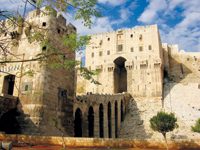
WHILE Syria has been in the news for its political unrest, the country continues to facilitate its tourism offering to visitors.
It recently launched the Shamgen visa – a joint visa allowing entry into the country along with Iran, Turkey and Iraq. According to Bassam Barsik, director general of Syria development and tourism marketing, this is expected to boost the number of Arab travellers visiting Syria, a trend that was witnessed last year too.
“2010 saw more than 9.5 million visitors into Syria – 8.5 million tourists and about one million day visitors. This was a huge increase of 40 per cent from 2009. Looking back from 2005 to 2009, our annual growth rate has been about 15 per cent. So, 2010 was an exceptional year for tourism in Syria,” he said.
Barsik added that the huge growth in numbers was greatly influenced by the aggressive marketing promotions undertaken by the tourism board.
“We went all out and focused on several countries, which in turn reacted positively to our marketing campaigns. The second thing is the cancellation of visa requirements with countries like Turkey and Iran. The Arab countries too don’t need a visa to enter Syria, all these reasons influenced the boost in arrival numbers.”
In fact Arab countries have always been the key source markets for Syria. But the country is being actively promoted to European travellers which is having a positive impact on the numbers coming from Europe, including Germany, France, Russia, Italy and Spain.
“In addition, our strategic location, between Europe and the rest of the Middle East, has seen an increase in business travellers through Syria,” said Barsik.
Looking ahead he is cautiously optimistic about 2011 saying: “In general, our tour operators have seen some group cancellations, however in Syria it hasn’t been too many – this is not OK though, because a cancellation is still a cancellation and some of these bookings were made almost a year ahead. Given the unrest in the region, it is vital that we look beyond the immediate future. We need to focus and continue promoting the country, to ensure our guests come back next year.”
Syria’s tourism products stem from its historical and cultural offerings. “Guests come to enjoy the nature, the coast, the mountains and the history as well as for religious tourism,” said Barsik. “We are working to offer added value with more events. We would like for tourism to be a tool for development in the region.
“For the Western guests, we have cultural and religious tourism offerings. Syria is an open museum with thousands of archeological sites. We are also looking to diversify our products into eco-tourism, river-tourism, mountain-tourism, business-tourism and desert-tourism.”
At the recently concluded ITB Berlin 2011, the international tourism industry and the UN World Tourism Organisation (UNWTO) came together to make a commitment to the Silk Road, an interconnected network of trade routes that runs through Turkey, Syria, Turkmenistan, China and other countries throughout Asia. The results of online market research were revealed at the event, showing that the historic trade network is the world’s most sought-after international travel route.
